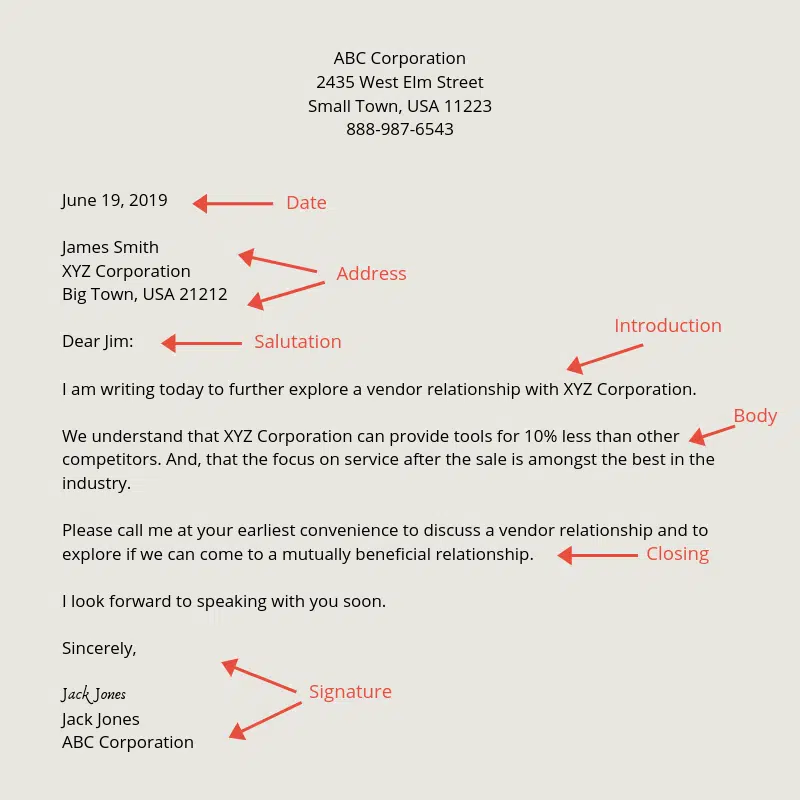What are the Seven Parts of a Business Letter?
Estimated reading time: 4 minutes
Writing a professional business letter is a vital part of business communication.
Written communication with customers, vendors, or other businesses is a developed skill that requires practice.
Understanding the proper business letter format and the parts of a business letter and practicing writing is key to effective business correspondence.
The business letter is a little more formal than written business communications such as email, memos, or text messages.
It is important to know the audience so the letter’s tone can be professional but not overly formal.
When drafting a letter, the author should assume that the reader has limited time and is looking for the bottom line and how it relates to them.
Ensure the substance is clear, specific, and to the point so the reader can quickly assess the letter.
In many cases, the business letter is the first impression, so it is important to ensure the content is accurate and free from errors.
This includes proofing the letter for content clarity and typos.
All business letters should be printed on the business letterhead.
If a formal letterhead is not available, the name of the company with address, contact phone number, and email should be printed on the top center of the paper.
So, what are the seven parts of a business letter?
1. Date
The date is at the top of the page for any business communication.
The date is a critical piece of information documenting when the correspondence was sent.
This is important for correspondence that may be kept for future reference.
2. Address
The address of the person receiving the correspondence includes a formal name, street address, city, state, and zip code.
Don’t forget to double-check the spelling of the person’s name.
A misspelled name is careless and unprofessional and can negatively impact the response to the letter.
3. Salutation
The salutation is the formal way of addressing the person.
Common salutations are Dear or To Whom It May Concern.
Some people have sensitivities about what name is used to address them, so be sure to take the time to identify the person’s most commonly used name.
For example, if the person’s name is Robert, try to find out if he goes by Robert, Rob, or Bob. For instance – Dear Bob,
4. Introduction
The first few sentences of a letter are introductory.
The introduction section introduces the subject of the letter.
It is a summary in a sentence or two that explains the goal of the letter.
For example, an introduction may be something like:
I am writing today to explore a vendor relationship with XYZ Corporation further.
5. Body of the Letter
The body of the letter is where the bulk of the information is shared.
The body of the letter explains in detail all aspects of what is being communicated.
This would include details of the information being shared.
For instance, the body may be something like this:
We understand that XYZ Corporation can provide tools for 10% less than other competitors. And, that the focus on service after the sale is amongst the best in the industry.
6. Closing
The letter’s closing summarizes the letter and any next steps or action items.
This section gives the reader a heads-up that the communication is closing.
For instance, the closing may be something like this:
Please call me at your earliest convenience to discuss a vendor relationship and to explore if we can come to a mutually beneficial relationship. I look forward to speaking with you soon.
7. Signature
The signature section has a complimentary closing.
Examples are Sincerely, Warmest Regards, Respectfully Yours, Very Truly Yours, or Cordially Yours.
Be sure to gauge the audience when selecting a complimentary closing.
After the complimentary closing, space is left for the signature that goes above the typed name and title of the person sending the letter.
7 Parts of a Business Letter

Life has gotten casual, and many businesses have also taken a more spontaneous approach to many aspects of their operation.
However, there are times when a well-written business letter communicates an organization’s intent to do business.
When that time comes, it is even more important to know the proper way to structure such a letter.






